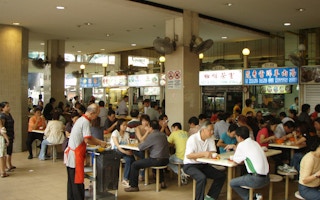A social enterprise model for some of Singapore’s hawker centres has been criticised over high costs and poor management, as the wealthy nation tries to revitalise its popular food stalls.
The hawker centres, which offer local and regional foods for just a couple of dollars, are an ever-present part of Singapore life and a source of pride, with two stalls having won a Michelin star in 2016—the first street food stalls to do so.
The government, which manages the hawker centres, sees them as vital in providing jobs for the less privileged, ensuring cheap meals for low-income residents and attracting tourists.
But the trade is struggling with competition and a failure to lure younger talent.
Seeking solutions, the government handed management of 13 of the city’s 114 hawker centres to social enterprises, which do good while also earning a profit.
“
The intention is good, but they’ve turned something that is meant for public good into something for private good.
Jack Sim, social worker and entrepreneur
But some of the new centres that are managed by social enterprises have been criticised over poor management, high rentals and strict conditions imposed on hawkers, many of whom are elderly.
“The intention is good, but they’ve turned something that is meant for public good into something for private good,” said Jack Sim, a social worker and entrepreneur.
“The model does not benefit hawkers,” he told the Thomson Reuters Foundation on Tuesday.
Singapore’s National Environment Agency (NEA), which oversees hawker centres, did not respond to e-mails seeking comment.
The NEA has said that despite the problems, the social enterprise model is “here to stay”, and that it benefits hawkers, cleaners and patrons.
It is “one of the ways we are trying to address the many challenges of the hawker trade such as renewal and manpower constraints,” Amy Khor, senior minister of state for environment, told parliament in November.
The model lets hawkers try new ideas to “bring vibrancy” to the trade, while ensuring that Singaporeans “continue to have access to affordable food in clean environments, and that our hawkers can earn a decent living”, she said.
Cashless payments, automated tray returns and centralised dishwashing have all helped cut costs for hawkers under this model, said Khor.
Singapore last year topped the Economist Intelligence Unit’s Global Food Security Index of 113 countries for the first time, scoring high on measures such as affordability and availability.
The cheap meals in its hawker centres are a vital part of this, and the city is also boosting local agricultural production.
The government said in 2011 that it would build 10 new hawker centres, the first to be built in decades.
It is also pushing for a world heritage tag for them this year from the United Nations cultural agency.
If the social enterprise model is to continue, Singapore should allow an independent team to check that they deliver on the promise “to make the hawker food culture viable, affordable and sustainable”, wrote KF Seetoh, a popular food blogger.
This story was published with permission from Thomson Reuters Foundation, the charitable arm of Thomson Reuters, that covers humanitarian news, women’s and LGBT+ rights, human trafficking, property rights, and climate change. Visit http://news.trust.org.

















